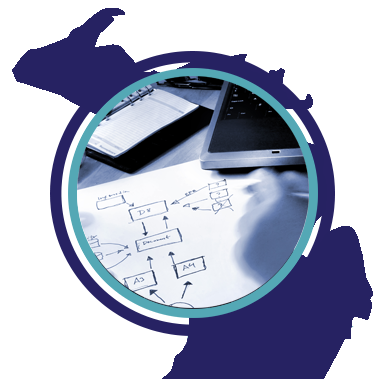Plans We Support

Great Lakes Pension administers plans from the very simple, straightforward plans to those requiring a highly customized design to meet specific needs of the owners or a particular group of employees. The Great Lakes Pension staff is uniquely qualified to handle sophisticated plan design with our multi-credentialed Consultants and in-house Actuary. We help you understand the important consideration involved in establishing a total retirement program.
Our professionals and systems are well-suited to work with a variety of retirement plans, including:
401(k)
A 401(k) plan is the most well-known and popular plan type. It is a defined contribution (DC) plan, typically a profit sharing plan that contains a cash or deferred arrangement as described in section 401(k) of the Internal Revenue Code. A cash or deferred arrangement is simply one that allows plan participants to elect to defer a portion of compensation, their elective deferrals, and have it contributed to the plan on their behalf through payroll withholding. The employer may contribute to the plan by matching all, or a portion, of the elective deferrals or by making non-elective, or profit sharing, contributions to all eligible participants. Safe Harbor and Carve-out plans add provisions that allows easier participation and non-discrimination testing. Optional provisions may include Roth, Safe-Harbor, and/or Profit Sharing contributions (allocated in New Comparability, Cross-Tested and Age-Based formulas.
401(k) Plans are ideal for:
- Employers who are initiating a plan due to employee demand for an employee saving option
- Employers wishing to minimize contributions
- Employers wishing for discretionary contributions
- Plans with low participation rates (Safe Harbor)
Defined Benefit
A Defined Benefit plan (DB) is considered a traditional pension plan because it guarantees a monthly pension benefit for the life of the participant. A DB plan does not maintain account balances to reflect the accrued benefit of each participant, but must define a benefit formula and how the benefits are accrued under that formula. This type of plan favors older employees with longer terms of service.
A Cash Balance plan is a type of Defined Benefit plan. By taking advantage of age and salary differences, a Cash Balance plan tilts the contributions towards a desired employee or group of employees. Unlike a traditional Defined Benefit plan however, a Cash Balance plan provides a “hypothetical” account balance for the participants which accrues interest at a pre-defined government rate.
Defined Benefit Plans are ideal for:
Employers who are older and have more service than other employees
Employers wishing to maximize contributions
Employers with substantial resources
Employers with stable income
Cash Balance (A type of Defined Benefit Plan)
A Cash Balance Plan is a type of Defined Benefit Plan that has gained much popularity in recent years. By taking advantage of age and salary differences, a Cash Balance Plan tilts the contributions towards a desired employee or group of employees. Unlike a traditional Defined Benefit Plan however, a Cash Balance Plan provides a “hypothetical” account balance for the participants which accrues interest at a pre-defined government rate.
Cash Balance Plans are Ideal for:
Employers who are older than some of the staff employees
Employers desiring larger contributions for certain classes of employees
Employers with substantial resources
Employers with stable income
Profit Sharing
A Profit Sharing plan is a type of defined contribution plan. The employer’s contribution to a Profit Sharing plan is not required to be fixed, nor does it need to be tied to profits. While a plan may have a definite contribution formula, many plans use a discretionary formula under which the employer determines each year how much to contribute.
Profit Sharing Plans are ideal for:
Employers with fluctuating income that want to make discretionary contributions
Profit Sharing with New Comparability or Cross-Tested and Age-Based Formula
A New Comparability or Cross Tested plan is a hybrid plan that combines features of both defined benefit and defined contribution plan generally to skew the employer contributions in favor of the older, higher paid employees. These plans provide the ability to create multiple benefit levels and are flexible in their contributions. The participant’s age, service and compensation are taken into account when determining the allocation of these contributions
New Comparability Cross-Tested and Age Based Plans are ideal for:
Employers who are older than some employees
Employers desiring larger contributions for themselves and possibly other key employees
Employers desiring flexible contributions
Money Purchase and Target Benefit
Money Purchase plans, as well as Target Benefit plans, are older plan designs that were at one time favorable in certain situations. However, with changing governmental regulations providing newer, more flexible plan design options, these two plan types are now less attractive to most plan sponsors. If your company is currently sponsoring a Money Purchase or Target Benefit plan, we invite you to contact us for a free plan design consultation to see how today’s current regulations, plan design options and tax planning strategies may result in a superior retirement plan solution for you and your employees.
Related pages
Plans We Support
Plan Design & Administration
See a Plan Comparison
Ask yourself if what you are doing today is getting you closer to where you want to be tomorrow.
